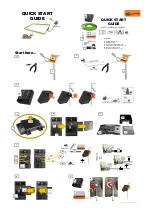
MIA-M10Q - Integration manual
The section
defines measures against in-band interference during the design phase
of the application.
3.3.2 Out-of-band interference
Out-of-band interference is caused by signal frequencies that are different from the GNSS carrier
frequency. The main sources are wireless communication systems such as LTE, GSM, CDMA,
WCDMA, Wi-Fi, BT, etc. Typically, these systems may emit their specified maximum transmit power
in close proximity to the GNSS receiving antenna, especially if such a system is integrated with
the GNSS receiver. Even at reasonable antenna selectivity, destructive power levels may reach the
RF input of the GNSS receiver. In addition, larger signal interferers may generate intermodulation
products inside the GNSS receiver front-end that fall into the GNSS band and contribute to in-band
interference.
Measures against out-of-band interference include maintaining a good grounding concept in the
design and adding a GNSS band-pass filter into the antenna input line to the receiver.
and
information about the RF immunity of the MIA-M10Q module and how to mitigate out-of-
band interference.
3.3.3 Spectrum analyzer
The UBX-MON-SPAN message can be enabled in u-center to provide a low-resolution spectrum
analyzer sufficient to identify noise or jammers in the reception band. Once enabled, u-center
includes a real-time chart that is updated once per second with the message data. See
for an example.
The shape of the spectrum as well as any RF interference in the form of a spur or intermodulation
product can be easily analyzed with this graphical tool. The vertical axis compares the amplitude
difference in dB for each frequency. A good spectrum shape is characterized by an even noise floor
along with the GNSS band. For example, if any unwanted spur stands out, the vertical axis gives a
rough approximation of the power level in dB compared to the noise floor.
Next to the chart, the center frequency, span, and resolution values set for the spectrum, and the
PGA value are also displayed. The PGA value represents the internal gain set by the receiver, which
depends on the external amplification of the GNSS input signal.
The vertical discontinuous lines in the chart area represent the offset to the center frequency in
MHz. This helps to estimate the frequency of any spurious emission seen.
In addition, u-center includes three functions commonly found in any spectrum analyzer. These
features support the RF front-end design and help to spot out any jammer presence during the
application operation.
• View / hold: if selected, the current spectrum shape freezes in a colored line. This allows for a
comparison between the time the spectrum was frozen and the real-time spectrum. This is
particularly helpful in assessing the impact of running other onboard components.
• Average: if selected, a colored line shows the averaged spectrum for each frequency. This
supports the analysis over time and obtaining a less noisy shape.
• Max hold: if selected, a colored line shows the maximum amplitude measured at each
frequency. This option helps to spot out any jammer over a period of time.
shows the spectrum view in u-center with the view/hold option selected. The redish line
represents the frozen spectrum before modifying the external gain, while the black line represents
the current measurement.
UBX-21028173 - R01
3 Hardware integration
Page 68 of 89
C1-Public
















































